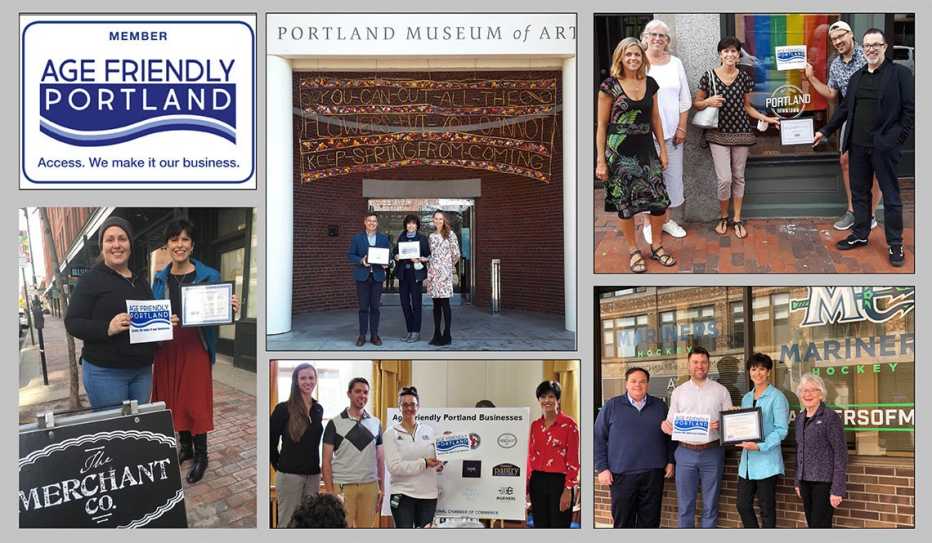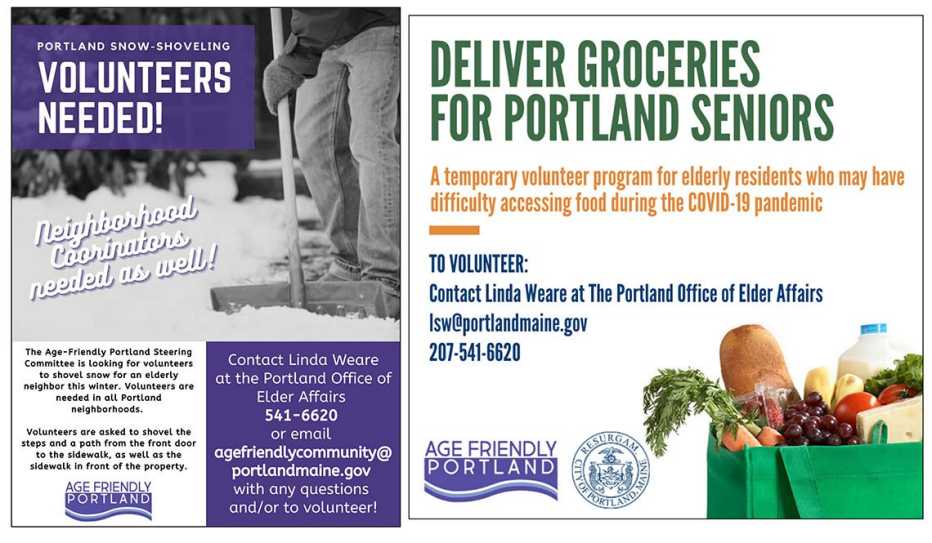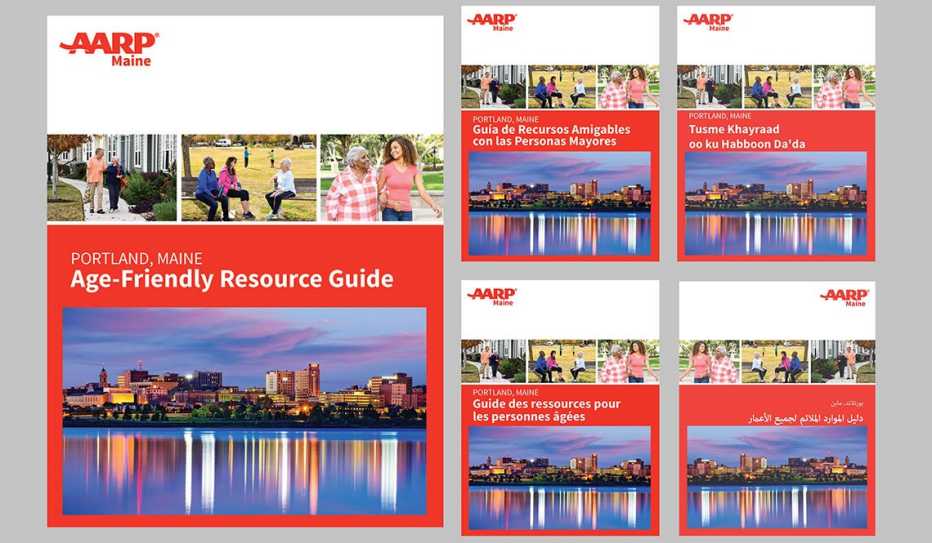AARP Hearing Center


ACTIVITIES AS OF MAY 2022
Member Profile
Compared to the statewide population of Maine, where a quarter of the population will be 65 or older by 2025, the city of Portland is relatively young — of its 68,000 year-round residents, 15 percent of whom are over 65.
Initiative Name: Age Friendly Portland
Network Member Since: 2014, when Portland, which is Maine’s largest city, became the first community in the state to join
Government Type: The city is led by a council-manager with a nine-member city council that includes a popularly elected mayor.
Local Age-Friendly Leadership: Portland’s age-friendly program is led by Linda Weare, the director of the city’s Office of Elder Affairs, which oversees age-friendly.
Reason(s) for Joining: “Our mission at the Office of Elder Affairs is to help people in Portland stay independent and get the services and help they need as they grow older,” says Weare. “The age-friendly network was a natural fit for the mission of my office. Maine is the oldest state in the nation as far as our median age goes. Our population is aging at a rapid pace and to not pay attention to making our communities livable for people as they age is just not acceptable.”
The Financials: Weare’s salary is paid by the City of Portland and covers time spent working on age-friendly network-related efforts. Other funding comes from grants, including a 2022 AARP Community Challenge grant for purchasing portable ramps and doorbells for businesses in the downtown district with entrances that are currently inaccessible to people with mobility challenges.
Getting Started: In 2014, the mayor asked Weare to meet with AARP Maine, which was speaking with communities about joining the age-friendly network. With help from students at the University of Southern Maine’s Muskie School of Public Service, Weare conducted a community needs assessment and hosted a community summit to reveal the findings to potential stakeholders. A group of 14 elder services providers and older community members were then invited to form the Age Friendly Portland Steering Committee.
Actions and Achievements
Portland submitted its current Age Friendly Community Work Plan, or action plan, in 2016. The steps taken thus far include the following:
Age-Friendly Businesses


“The business community wasn't part of the steering committee that did our age-friendly needs assessment,” Weare explains. “It was a glaring omission on our part. At the time, we were focused on service providers and nonprofit organizations that work with older people. But what makes Portland such a great place is its restaurants, shops and other businesses.”
The Business Checklist
Visit the Age Friendly Portland Business & Organization Application — then scroll down and click the "Next" button to find the list.
Portland’s age-friendly business initiative began in 2017 with the goal of helping local shops, eateries and businesses become more accessible to older customers. A business that meets the criteria receives a framed certificate and decal that can be displayed in a storefront window. The designation can also be used in advertising and on the business’s website.
The program was really taking hold, with some 14 businesses designated age-friendly, when COVID hit. The age-friendly team hit the pause button. Today, a top priority is, says Weare, “making residents aware of how many people are over the age of 50. With the business community, in particular, there have been some aha moments where you see that light bulb go on.”
“Every item on the age-friendly business checklist [see box] is something of an aha moment,” says Cary Tyson, the executive director of Portland Downtown and a new member of the age-friendly steering committee. “Receiving the age-friendly designation has helped us as a leading voice in our advocacy for accessibility. It’s given us credibility,” he says.
Tyson’s advice to other businesses? “Certification is quick, easy and painless. Just going through the checklist is worth your time and is enlightening. The changes, if needed, are easy and cheap, and often free. Get designated!”
The Portland Museum of Art is also certified as an Age-Friendly Business. Mike Brown, the museum’s director of sustainability, cites an aha experience that was nothing short of transformational: “When I first started to work with the museum, much of the planning for the new front doors had already been done. They were custom-crafted plate glass doors that couldn’t be retrofitted to include automatic openers. Although quite beautiful, they didn’t reflect who or what we are as a museum, which in large part is about removing barriers to ensure art for all. The doors created a first impression to some users that was anything but welcoming.”
So Brown consulted with Alpha One, an accessibility advocacy organization, for guidance on making the entrance accessible to all. “The installation of the doors coincided with a brief closure,” Brown explains. “When we reopened, the reaction of our most frequent guests was visceral. You could see the smiles on their faces and their eyes brightened in acknowledgement that something magical had occurred to transform our entryway.”
Help for Deliveries and Heavy Lifts


The AARP article “Why Shoveling Snow Can Trigger a Heart Attack” notes that some 11,500 people every year in the U.S. are treated in emergency rooms for shoveling related incidents. In some communities, including in Portland, homeowners are required by law to clear the snow and ice from their sidewalk after each storm. Failure to do so can result in a warning and then a fine.
Age Friendly Portland’s snow shoveling service pairs an older resident or homeowner with a volunteer who shovels steps and sidewalks and clears a path from the front door to the sidewalk. The unfunded, all-volunteer program is in its fifth year and growing every winter.
“We started out with just two neighborhoods and now have more than a dozen participating,” says Weare. “Every time we post a recruiting ad, which we do on Facebook and other apps, we always get new volunteers stepping up.”
Becky Junkins is one of the program's 100 snow-shoveling volunteers and a neighborhood coordinator. “Our neighbors are delightful and always grateful for the work our volunteers do,” says Junkins.
“I have lived away from my aging family for most of my life. It’s important to me that people helped care for them while I couldn’t due to the distance. I feel it is an honor to serve and care for our aging neighbors.”
Homeowner Diane Shea, 63, was the go-to snow shoveler for her elderly neighbors until 2017, when she permanently injured her left hand. “You don't get young kids knocking on your doors anymore, asking to shovel your driveway,” she says. When her sister suggested she call the city to see if it had a program that helps with snow shoveling, Shea was skeptical but called anyway. “A godsend” is how she describes the two teenagers who subsequently arrived at her home, shovels in hand.
Local leaders are big fans of the shoveling service. “A city councilor will get a call from a constituent worried that he can’t shovel his driveway — so the councilor refers that person to me,” says Weare.”
A Resourceful — Multilingual — Guide


Portland, Maine's Age-Friendly Resource Guide contains information about vital services and amenities available to older adults in Portland. First published in 2018 with help from AARP Maine, the guide was updated in 2020 and translated into multiple languages to better serve the changing needs of the city’s increasingly diverse population.
“We found out the four languages most commonly spoken by new Mainers are Somali, French, Spanish and Arabic,” says Weare, who worked with organizations that serve immigrants and refugees to distribute the translated guides. “The older members of families that come here as refugees or immigrants tend to be more isolated. They're not going to school. They might not be employed. They don't have as many opportunities to learn the language and get integrated into the community as much as the younger people do. Providing the guide in their language is one small thing we could do to help them be a little more connected.”
And in another resource guide update, the 2022 edition of the visitors’ guide published by Portland Downtown includes a notation next to each business and location listing that it has been designated age-friendly.
Lessons Learned (and Advice for Others)
Show Up — from the Start
From Portland’s earliest foray into joining the AARP Network of Age-Friendly States and Communities, Weare and the newly created steering committee made a point of attending all community forums, meetings or planning sessions. At the time, the city was creating a new comprehensive plan. “We wanted to ensure that the things older citizens had told us in the needs assessment got considered in any of that planning,” she says. The findings of the needs assessment found their way to the city’s plan, particularly as relates to housing and transportation. “I don't think those initiatives would have been included had we not showed up, raised our hands and said, ‘Don't forget this group,’” she adds.
Prepare to React
The arrival of COVID-19 meant that Age Friendly Portland had to implement programs and services that were never part of its action plan. Using the initiative’s Facebook page, Weare recruited 75 volunteers in three weeks. After undergoing a background check, the volunteers were deployed to do grocery shopping and pick up food from community pantries for delivering to homebound seniors.
Create Awareness
Weare stresses the importance of making the public aware of how many people in the community are over the age of 50 and what it means to be “age-friendly.” As an example, she cites doing a walkthrough at a business that was applying for the age-friendly designation. The location had a beautiful area rug on the floor that was a serious tripping hazard. The owner hadn’t realized that the rug was a potential problem — for older adults and people of all ages.
Just Ask
An ongoing question asked by Portland and other communities: “How do we do these important projects without added resources?” One of the answers is to tap into the potential of volunteers. “You really can do a lot with volunteers and people who have an interest and a desire to roll up their shirtsleeves and get involved,” says Weare. “Don’t underestimate the value of people's goodwill and willingness to volunteer if you ask them, and you're specific and tell them what you really need help with. I've been so impressed by how willing people have been to step up once they understand what the need is.”
Cast a Wide Net, Prepare an ‘Elevator Speech’ and More
- “Use all of your contacts and connect with city officials such as councilors, managers and the mayor. Make sure they know what you’re doing so they can, in turn, tell their constituents.”
- “Be ready to tell a stranger, in 30 seconds or less, what age-friendly is and why it’s important.”
- “Don't get caught up in trying to do everything perfectly. Do what is practical given the resources you have — and be creative about it as well.”
Reporting by Amy Lennard Goehner































.jpg?crop=true&anchor=13,195&q=80&color=ffffffff&u=lywnjt&w=2008&h=1154)





























